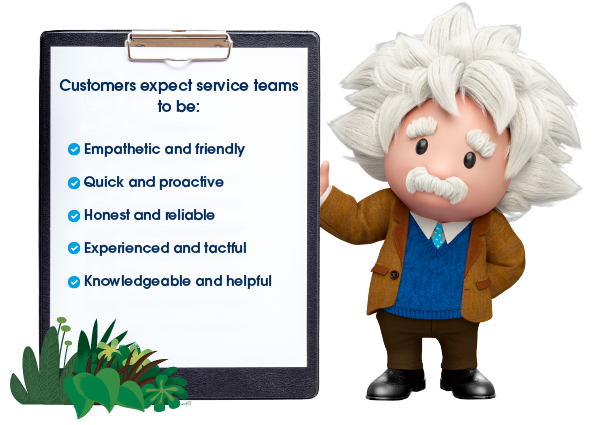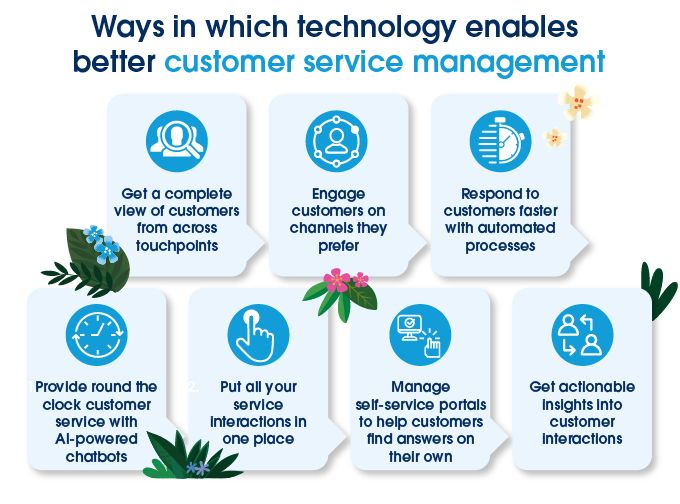Introduction
Customer service is not just about being cordial to and helping your customers when they are making a purchase. Customer service includes everything a company does to smoothen customer experience before, during, and after sales.
Good customer service delights customers, and sets businesses apart from their competition. The better your customer service is, the stronger retention and brand loyalty you can build.
For this, it is important to establish good customer service management practices, processes, and teams that make customers feel valued.
What is customer service management?
Why customer service management is important?
According to Salesforce’s fourth edition of the State of Connected Customer report, 79% of consumers and 85% of business buyers consider experience as important as the products and services companies provide.
Customer service management makes doing business with you more convenient and helps you continuously improve customer support. This is more important than ever as today’s customers have access to varied knowledge and choices, making it easier for them to switch to competitors that may be offering better service than your company.
As companies and their customer bases grow, developing processes and systems that streamline how customer information and requests are managed is important. This requires building strategies that can guide your customer service management. Adopting the right customer service management software can also make managing customer expectations easier, and enable digital-first services.
Types of customers
Customer service management is all about understanding your customers and their needs and fulfilling them in the best way possible. The first step here is to get to know your customers. Here are common customer types you need to know about:
- The potential customer or prospect – is the one who shows interest in your offerings and resembles your ideal customer persona. They spend time on your website, browsing through product or FAQ pages, to gather information about your offerings. Technically, they’re not your customer yet but can be converted into a paying customer with some nurturing. They need to see the value you can provide and how your offerings are better than others in the market.
- The novice buyer – may be buying from you for the first time, and the first impression you create with them can determine if they will buy from you again. Since they are new and not fully aware of your offerings, they may need extensive attention initially – whether it is regarding the buying process or post-sales support. Follow a proper onboarding process and tell them how to use your products properly. This will ensure they get the most value out of your products and return for more.
- The loyal ones – are buyers who have been around for a while and are the most likely to recommend your brand to others. They know their way around the buying process and your offerings. They should never feel unrecognised or ignored. While they may not let go of you after one bad experience, make it your company’s utmost priority to offer loyal buyers the best of everything. In fact, try and get their feedback whenever possible. You can use this information to improve your products and services and replicate the factors that make their experiences good to win more loyal customers.
- The impulsive buyer – makes quick decisions and doesn’t need much convincing. If they have paid your website or app a visit, chances are they will not leave without buying. But they will retract a purchase as quickly as they decide to make it in the first place. Make the buying process as easy, convenient, and short as possible, as impulsive buyers are characterised by impatience too. They are good candidates for occasional cross- and upselling. If the additional products or services you suggest better suit their needs, they will appreciate your active involvement in helping them make better purchasing decisions.
- The sceptical customer – is afraid of buying the wrong products or falling for deals that may look good but aren’t. They take the time to do thorough research and sometimes even miss out on great offers due to their indecisiveness. They reconsider purchases till the very moment they press ‘pay’. The key is to win their trust with prompt, reliable customer service. They are more likely than most other customer types to reach out for help. When they do, avoid being pushy. Instead, focus on establishing value and addressing factors that are keeping them from making a final decision.
- The researcher – is a type of customer that is highly aware. They already know your company and offerings fairly well. It is very likely that they have compared your products or services against those offered by your competitors. They know what they want and have high expectations. It is imperative to be straightforward and honest with this customer type. If you don’t have something this customer is looking for, admit it and offer a practical solution. Once you win them over, they become the most loyal customers.
- The discount chaser – is always looking to get the most value out of everything they buy. If they are reaching out to you, they are already interested in your product or service but are looking for attractive deals. You can attract them with a discount or offer, but also help them see the additional value you can offer to keep them coming back.
- The angry bird – is someone who may have had an unsavoury experience with your company or generally doesn’t react well to even minor inconveniences. While it is important to call out misbehaviour, customer service agents can lend them an empathetic ear. Try to calm them down without being condescending. The sooner you get to the root of their problem, the easier it is to steer the conversation to a fruitful end for all.

Types of customer needs
Customer needs are ever-evolving, and this particularly changes based on the stages customers are at in their journey with your company. There are two broad categories of customer needs – related to the product or service that is being sold and additional services that you provide.
Most of the customers that reach out to you would already have done some research. They would know about the basic features of your product or have a fair idea about the different services you offer. But you may also have customers that are looking for a particular feature or functionality. For example, a furniture buyer may be looking for chairs with a special kind of back support or cushioning.
Customer service teams need to have a strong understanding of the different products or services their company provides, so they can help customers find the answers to specific questions that can make or break their buying decision. They also need to know what their competitors are offering and be able to justify their price point.
Similarly, customers may want to know if there are any special deal packages or payment methods that can make their purchase more cost-effective. Fair pricing and value are customer needs every company must meet.
Once customers make a purchase, they may have questions about the usage or maintenance of the products they bought. Or they may want to know about post-sales services and warranty details.
To create differentiation through good customer service, it should meet basic customer needs such as:
Empathy – in the way customer service teams approach customer challenges and requests
Speed – in responding to and resolving customer issues
Ease – of buying and returning purchased items or revising transaction terms
Transparency – in what can be offered and what isn’t possible
Guidance – to make informed buying decisions and optimally use the product or service
Accessibility – to customer support through their preferred channels
- Choice – of viable options, in terms of product variety, payment or delivery options available

How to satisfy customer needs
There are four fundamental factors to fulfilling customer needs. These are:
- Identifying customer needs: No two customers are the same, and neither are their needs. To know what your customers really need, you need to get to know them better. Use a CRM solution that allows you to collect and use customer data in a standardised manner. Analysing data can help you identify patterns in customer needs and categorise them under fine segments to target them better.
- Meeting varied customer needs: The is the logical next step after identifying customer needs. Once you know what different customer segments are looking for – whether it is faster delivery or customisation of products – you can build strategies that aim to fulfil the needs of different customer segments.
- Gathering customer feedback: This allows you to hear what they like and don’t or need and can do without from the horse’s mouth. Customer feedback helps you continuously improve your products and services. It also makes customers feel valued and heard when companies make changes based on their needs and demands.
- Measuring customer satisfaction with metrics that work for you: The kind of metrics you use to measure customer satisfaction depends on the type of products and services you offer, your industry, and the priorities of different customer segments. Using the right metrics gives you a better assessment of how your customers feel about your company and areas that need improvement.
Improving your customer service management
Quality customer service helps attract new customers and keep existing ones happy. Here’s how you can improve your customer service management to deliver exceptional experiences:
- Create a systematic plan and structure - that your customer service team can follow when dealing with different types of customers. Document and share guidelines, best practices, and customer insights in a customer service management playbook to guide your team.
- Be realistic - when planning your customer service structure, especially if yours is a small business or you are just starting to provide customer support. This will help you gradually build service capabilities while understanding what works and doesn’t work for your customers.
- Set goals and identify strategies to achieve them – for example, your goal could be improving customer satisfaction score. Start by listening to what customers need and what they are saying about your brand on social media and other platforms. You can also use chatbots or survey forms to really understand how to improve your products and service, which will directly impact their satisfaction levels.
- Establish the right systems and processes – and automate them to improve efficiency and predictability. Use a solution like Service Cloud that gathers tickets from all touchpoints and automatically routes them to the best agents based on the issue and urgency for fast resolution. And with complete customer data on their screens, service agents can provide smarter, more helpful solutions.
- Measure customer service metrics – like customer satisfaction, effort score, case resolution rates, etc. These metrics can help you understand what is working well and can be improved to make customers happier. This also helps customer service managers set targeted goals for their teams and measure their performance.

Customer service management tips to follow in 2022
Here are a few customer service management tips that are sure to increase customer satisfaction levels:
Tip #1: Hire people with skills and qualities that match your business’ needs
Processes and systems are important, but the quality of customer service you provide is largely determined by the people who run that front. It is great when service agents can speak well or are tech-savvy. But service team members need soft skills as well – like empathy, active listening, patience, etc. – to connect and communicate effectively with customers.
Tip #2: Clearly define roles and responsibilities within service teams
Broadly, customer service teams are responsible for handling interactions that have to do with managing service requests, case resolution, and answering queries. But service cases can be of various types and come in from multiple channels like email, live chat, calling, etc. Assigning specific roles and responsibilities among the right team members ensures customers are attended to at the soonest by the best-suited agents. It also prevents duplication of efforts and keeps service cases from falling through the cracks.
Tip #3: Enable communication and coordination with other departments
Service teams handle all kinds of customer interactions, and many of these are sales and marketing related. Use a system that enables data share across functions and enables service teams to easily connect with other departments. This can drastically improve service quality, particularly when working on complex cases.
Tip #4: Follow a customer service philosophy
Create customer service mantras that your service team can swear by. Saying “customers always come first” or “fast service is good service” may sound obvious. But customer service management is much more than just ensuring customers’ needs are addressed when they reach out to you. It is a way to really show what your company stands for and how you intend to build stronger customer relationships. When you reinforce this across the team, it becomes a guiding philosophy to deal with different types of customers.
Tip #5: Equip your service team with useful tools and technologies
Customer needs and expectations will continue to change. As your company grows, you also need to scale quality customer service. Provide your service team with tech solutions that make their job easier. For instance, Service Cloud puts all the necessary tools and customer data service teams need at their fingertips. All cases, from any customer service touchpoint, are queued and assigned to the most appropriate agent. The agent has a unified view of all data they need as well as knowledge articles - all on one console - so they can quickly and accurately respond to customers without having to toggle between multiple screens. So, customers' wait time is drastically reduced and their issues can be resolved the first time they reach out.
Keep your current customers for a lifetime
It is known that keeping customers costs lesser than acquiring new ones - almost 5-10 times less. To ensure customers stick around with your company for longer, customer service management should focus on –
- Building and following strategies that help retain existing customers. For instance, you can start a loyalty or reward programme to provide more value to regular customers.
- View customer complaints as opportunities to learn from. Showing customers that addressing their complaints is a priority for your business through prompt responses, first-time case resolution, and proactive follow-ups can help repair perceptions and build loyalty.
- Deliver consistent, continuous engagement to foster quality customer relationships. Nurturing is useful in identifying signs of dissatisfaction and opportunities to grow your relationship with customers.
Conclusion
Customer service management is all about understanding customer needs and fulfilling them in the most efficient manner. They say that 'service is the new sales'. Customer service teams are often seen as the face of their companies. Service agents closely interact with customers in defining moments in which brand perceptions are shaped.
Enabling smooth, efficient customer service management can help businesses zero in on issues their customers face and things they demand. But customer service interactions don’t happen on just one or two channels now. Most customers today expect the convenience of being able to reach out to businesses on multiple channels and switch between them seamlessly.
Using a solution like Salesforce Service Cloud offers service teams a single view of their customers and provides visibility into service cases raised on any channel or touchpoint in one place. It has a feature-filled and intuitive console that allows service agents and managers to access all the information and tools they need, to respond to customer needs with speed and context. It also helps you embed service capabilities into different channels and allows you to manage self-service portals to help customers help themselves.




